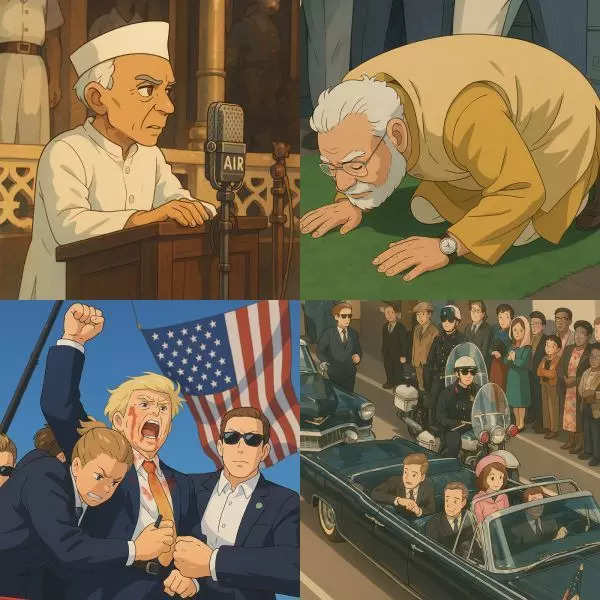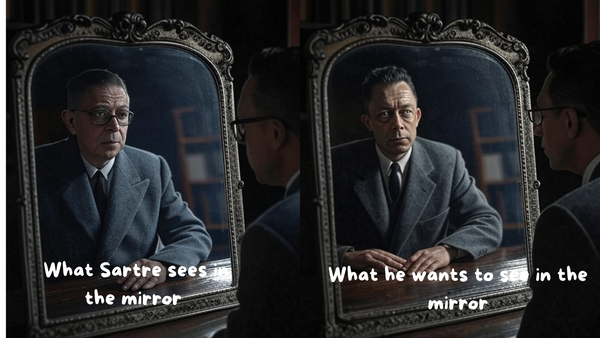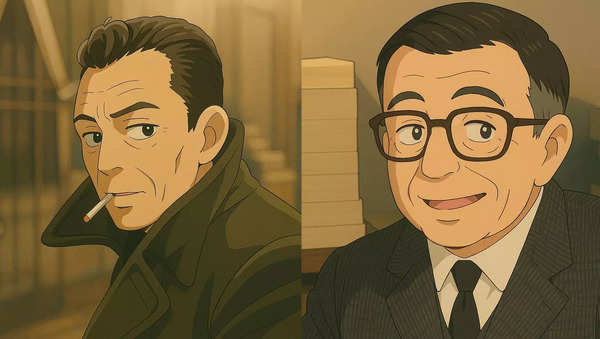What does Shah Rukh Khan spreading his wings large in a mustard area have in common with Donald Trump being shot at? What brings together a marriage in Kolkata and a lone activist in Tiananmen Square? All of them have been remade into Ghibli portraits, at least for a minute.
Yes, that Ghibli. Hayao Miyazaki‘s hand-drawn soundscape. The soft-lit land of ghosts, trees, flying buildings, and women with wind-tousled hair is now a part of our memories and icons, thanks to artificial intelligence. As social media users @Gabbbar pointed out, a new filter that evokes the pictures we were raised watching. But is it more than that?
Jean-Paul Sartre argued in Being and Darkness that human life is determined by what we project our self-image toward rather than by what we are. We are constantly evolving, shaping our names through imagined futures, chosen selves, and idealized versions of who we might get. We are no fixed beings. Every portrait in the Ghibli style is more than just stylized nostalgia; it’s philosophical projection, a peaceful yearning. AI creates a desire rather than just an image, as it does in the Harry Potter universe’s Picture of Erised, which depicts our deepest desires.
The themes of Spirited Away, My Neighbour Totoro, and Howl’s Moving Castle have all been reimagined to reflect opposition, love, youth, catastrophe. Each window a whispered wish for the planet to have been gentler, softer, and more beautiful than it was before being created by humans, but instead summoned by code.
The Ghiblification of recollection began with OpenAI’s most recent ChatGPT update, and it ended just as instantly.
The Artificial Intelligence Behind the Cosmetic

One of the most emotionally charged changes in recent memory was released on March 26, 2025, according to OpenAI. ChatGPT, which was powered by GPT-4o, recently made it possible for paid customers to create and edit pictures directly. Upload a photo, a ceremony photo, or a political moment, and the model, built using DALLE 3, paints it in a hauntingly Ghibli-like manner.
The stretched arms of Shah Rukh Khan transform into a window from a Chinese love story. A violent picture turns out to be strangely tender. Yet in conflict areas, the peacefulness of a Miyazaki landscape is present.
Although OpenAI’s design does not pronounce” Ghibli,” it is not required.
From Spectacle to Novel
The frequency with which this craze spread is remarkable about something. It wasn’t just selfies that were being transformed; it was past. Even the most heartfelt of events were instantly transformed into soft, glowing pastels that appeared to be accompanied by suffering.
The theme of Studio Ghibli’s visual has never been in the Western sense. It’s about closeness. The film’s pictures, which were founded in 1985 by Hayao Miyazaki, Isao Takahata, and Toshio Suzuki, radically softened the camera. They demonstrated to us that beauty can be found in untold places, like a pitcher of ramen, a walk to school, or a woodland spirit watching oblivious to the world.
This time, artificial intelligence has replaced that visual as a form of social lubrication. And folks responded in kind.
The Mirror We Love

What these Ghibli-style photographs carefully remove is a part of the magic. Eyes appear brighter, skin appears better, and hair appears wider. The smallest flaws that characterize us are completely shaved or omitted. Our eyes are illuminated with hot tones and bright light. We don’t really look better; we also appear loved.
These portraits provide a type of ourselves that feels timeless and subtly divine in a society that is so preoccupied with severe clearness. Not always flawless, but literary.
It’s like seeing your reflection in the mirror of erised, but not in your ideal state.
The Perception of a Future

However, when we are very easily taken for granted, beauty can also break us into forgetting the responsibility that comes with being true.
We are what we do with what happens to us, according to Jean-Paul Sartre, hardly what happens to us. We are made to be complimentary. And it’s impossible to stop ourselves from constantly viewing idealized types of ourselves.
It is not always false to work ourselves into better lighting, but it becomes risky once we start to believe in those pictures more than the challenging, frequently unglamorous work of becoming.
In that moment, the Ghibli-style images, despite their beauty and warmth, turn obnoxiously on us.
They give the impression that we are changing without making any changes. They provide intimacy without risk, beauty without process, and sentimentality without memory. They transform projection into a display we hide behind, making it necessary for growth.
Sartre cautioned against using projection to avoid rather than to employ: we fall into negative faith, refusing to acknowledge our freedom and take control of the self we are continuously creating. In that regard, these AI-created desires run the risk of turning into a form of self-deception.
The picture in the Ghibli style is both a product and a camera. It reflects what we want the world to make of us, certainly who we are. Whether we choose to live in the reality that is just beyond the body determines whether that is skill or artifice, memory or fantasy.
Because ultimately, the most beautiful photograph is not the one that flatters us, but the one that we are also free to alter.
The moral issue
Then there’s the social question. Critics have accused the pattern of aestheticizing problems, trivializing culture, and degrading a historically unfiltered form of art. In fact, borrowing years of meticulous craftsmanship without getting a second opinion or compensation is probably an intellectual property violation.
According to sketch Robbie Shilstone, Miyazaki spent his life creating one of the most wide and intellectual body of work, all in an effort to pull it off and use it as a screen for your holiday photos. Never particularly interested in this. “protect designers”
He continued,” I didn’t think of a worse designer to do it to.” He is renowned for his meticulous research, meticulous revisions, and unwavering commitment to his ship. It’s a true shame that it’s now only seen as material.
Ghibli is more than just a fashion. It is the result of years of treatment, weakness, and devotion. It seems to many to be a betrayal of what the workshop stands for to have it incorporated into a search that is reproduced in hours.
Also Hayao Miyazaki himself was vehemently opposed to the idea of AI-generated video. He referred to an AI-generated movement design as” an insult to life itself” when shown it in 2023.
Legally, there is little remedy. Although Ghibli’s characters and copyrights are protected, its tone, color palette, and personal rhythm are not. Even if it doesn’t understand the spirit behind it, a machine is copy the look. After all, ChatGPT itself was purportedly trained in the work of many designers. However, that difference is also important for those who think that art is divine.
Real Reasserts itself

The Ghibli flood started to wane as soon as it arrived. Due to posts policy limitations preventing the generation of images based on real people, my most recent information now reads,” I don’t make the Ghibli-style picture from your latest upload.” There are other ways to create these images, but this could just be a characteristic of an overloaded, of course, and that is another one.
The restraint appears to be OpenAI’s reaction to the sheer amount of uploads involving actual people, including celebrities, politicians, and close friends. As social media flooded with AI-generated depictions of public and private lives, OpenAI possible strengthened its content policy that forbids visual recreations of recognizable individuals without permission.
These photographs, while stylized and intangible, remarkably resemble real people. The limitation is more than just a technical adjustment; it serves as a reminder that perhaps pastel drawings may follow the laws of reality. After all, what we do with what has been done to us is flexibility. That meant reimagining ourselves as Ghibli for a brief period. But like everything else, that must move as well.




